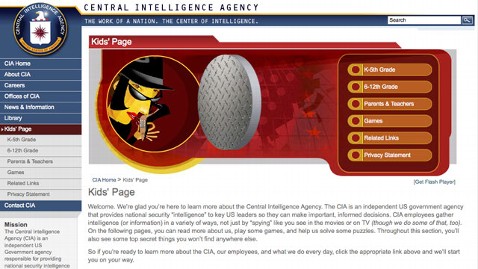CIA and NSA Websites Invite Children

Image Credit: cia.gov
Worried about what your children are getting into while surfing the Web? Well, how about organizations involved in intelligence gathering and espionage?
Despite their very adult missions, both the Central Intelligence Agency and the National Security Agency have sections specifically for youngsters.
On the CIA’s site – the same one that hosts definitions of cannabis, meningococcal meningitis and maternal mortality rate – children and teens can visit the Kids’ Page where a cubist cartoon spy using her high heel as a phone presides over a “welcome” telling readers they can “learn more about the CIA, our employees, and what we do every day.”
The NSA page is called America’s CryptoKids and looks more like a B-level animated movie than a government organization PR campaign. The NSA has games, puzzles and a cast of animal security officers, including Rosetta Stone the multilingual fox, Crypto Cat, who learned code breaking from an elderly Navajo nanny, and Cy and Cyndi, the cybersecurity twins welcomed into the CryptoKids family last year.
So how do the CryptoKids fit into the NSA’s mission “to protect U.S. national security systems and to produce foreign signals intelligence information?” And why would the CIA offer a word find and coloring book?
Communication expert Joanne Cantor said having games indicates that an organization wants kids to have a positive image of them.
Cantor said companies that see children as a target audience, such as fast-food chains or sweetened cereal producers, “have all sorts of games on their websites to make the kids like them and to sort of recruit them at young ages, and that’s very controversial among people who consider marketing to kids as unfair.”
Cantor did not see the CIA’s and NSA’s websites’ messages as inherently harmful, but said they could be subtle recruiting tactics.
“I think, particularly with character biographies, they want you to feel like you identify with the people who work there. Like this is something you could do,” Cantor said.
But Vanee’ Vines of the NSA Public Affairs Office denied that the agency uses its site as a recruiting tool.
“We’re aiming to raise awareness about cybersecurity, our mission, and how STEM [science, technology, engineering and math] skills are needed in a global society that increasingly relies on information technology,” Vines wrote in an email.
“We realize the importance of helping to educate the nation’s youth and raise awareness about the National Security Agency’s core values, vision, and critical mission.”
Online games provide an effective way to do just that.
A June 2011 study from Northwestern University said children ages 8 to 18 spend at least an hour and 17 minutes using a computer for fun on average per day, much more than they spend using it for schoolwork. The games on the NSA’s page, such as the one for learning Morse code or another that asks math and logic questions, give children the opportunity for entertainment and education.
The kids’ pages keep the dirty details normally associated with defending a country out of sight. The CIA page for high school students hints at “some challenging situations” that come up for their National Clandestine Service, but other than that, the information is dry, referring to paperwork and intelligence gathering.
“I don’t think it’s designed to be very educational for kids in terms of what these agencies do,” Cantor said, adding that the stiff tone of the more informational sections conflicted with the upbeat games and welcome pages.
These are just two of the 11 kids’ pages for the National Intelligence offices. The FBI’s page gets creativity points for its graphics that resemble an old Nintendo game. But perhaps it’s missing its target audience: Who under the age of 20 remembers what the original Nintendo looks like?
All federal agencies are strongly encouraged to have kids’ sections on their websites, thanks to a memo former President Bill Clinton released in 1997, but few are as elaborate as the NSA’s efforts. The memo does not specify how detailed the website must be or how much money should be allocated to the project.
While Vines said the NSA kids’ page has been reviewed frequently since the new design opened in 2005, she would not say how much it costs to keep the page “fresh and relevant.”
Kids can see more from the NSA’s gang of cartoon characters at the agency’s museum.